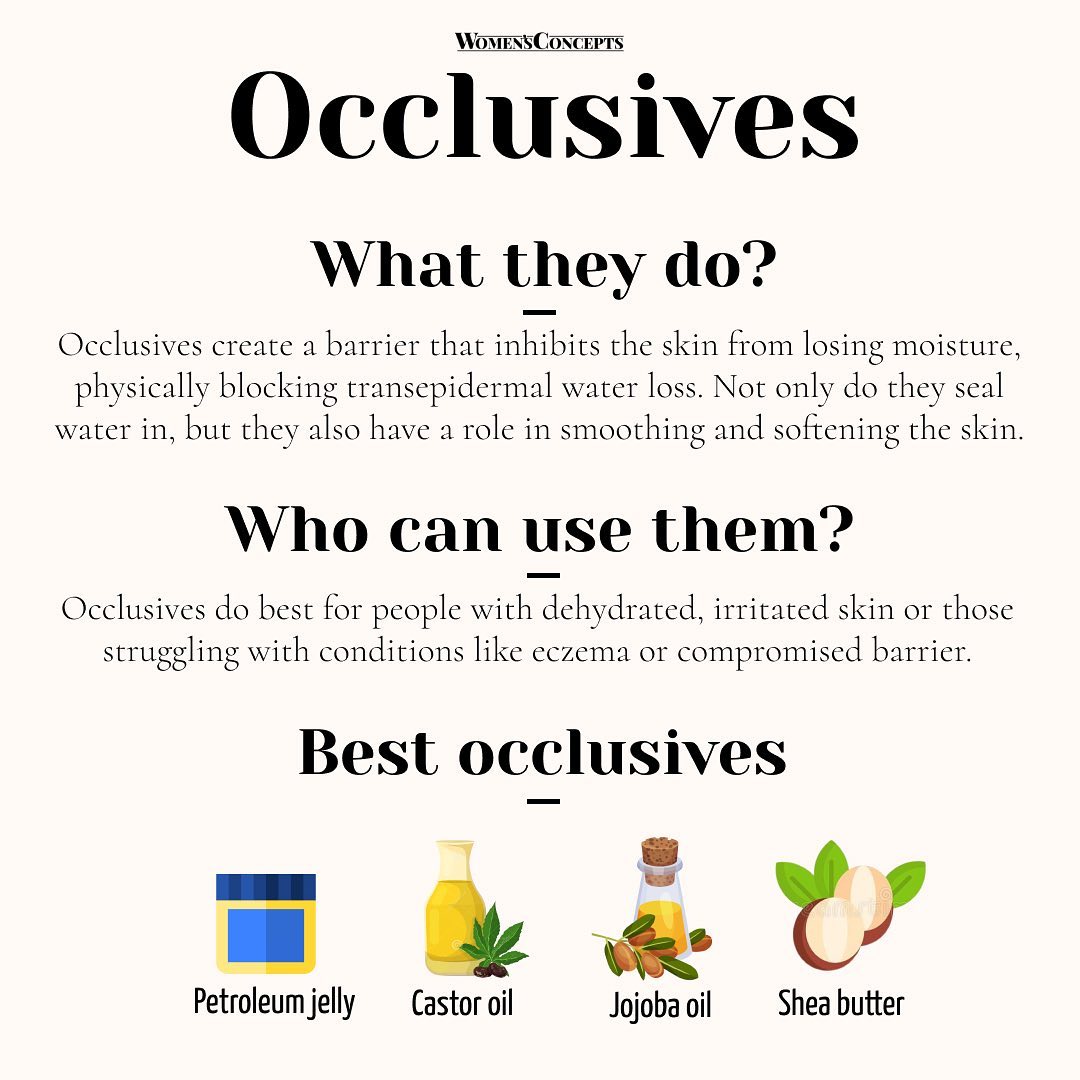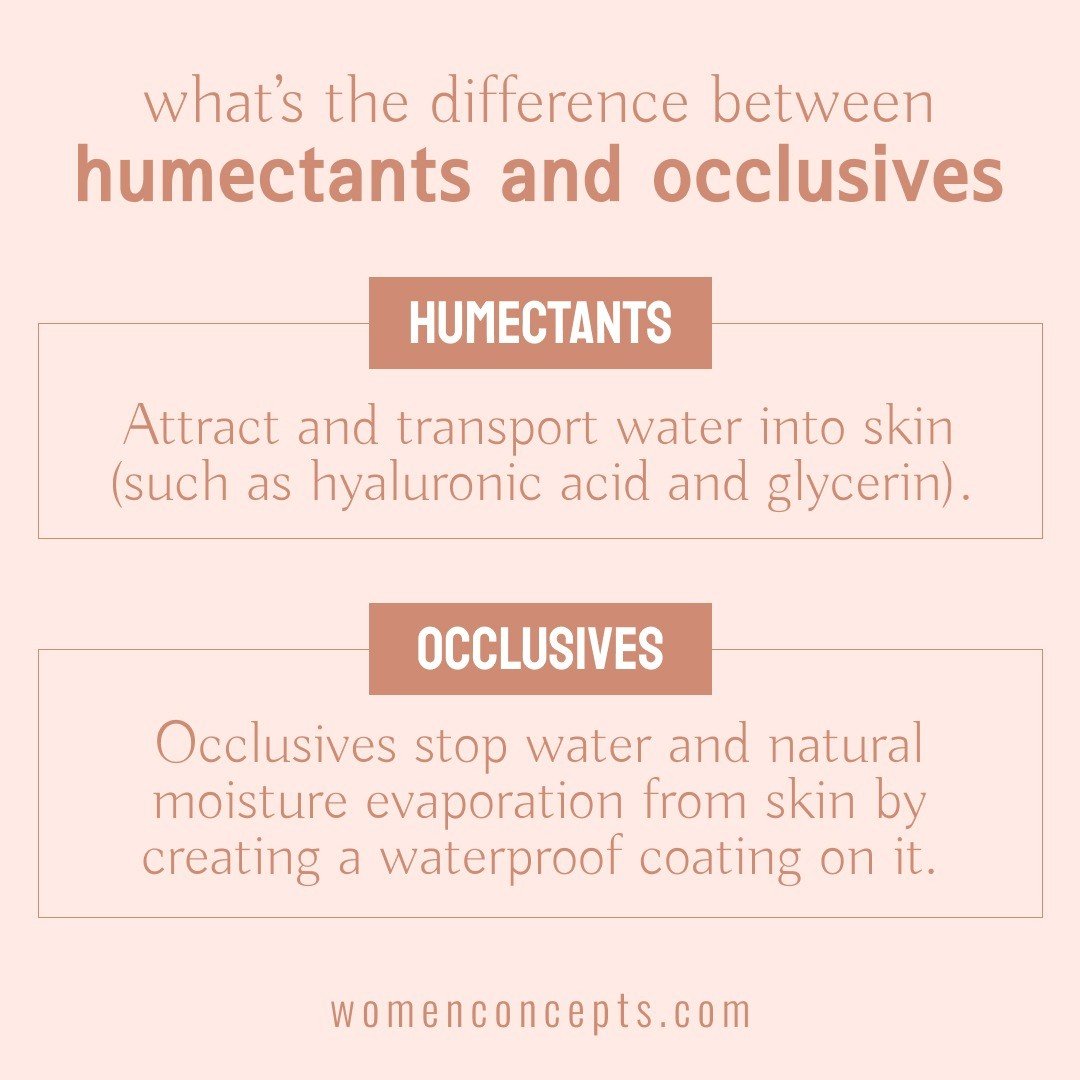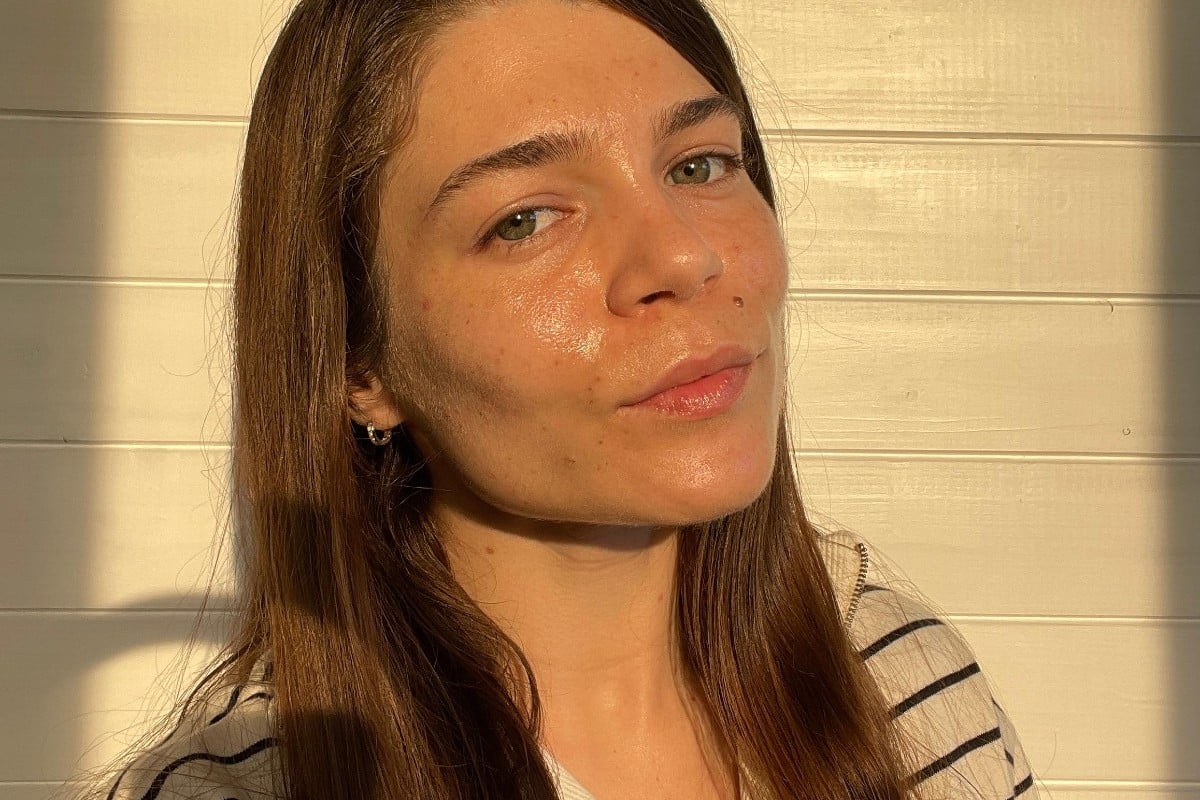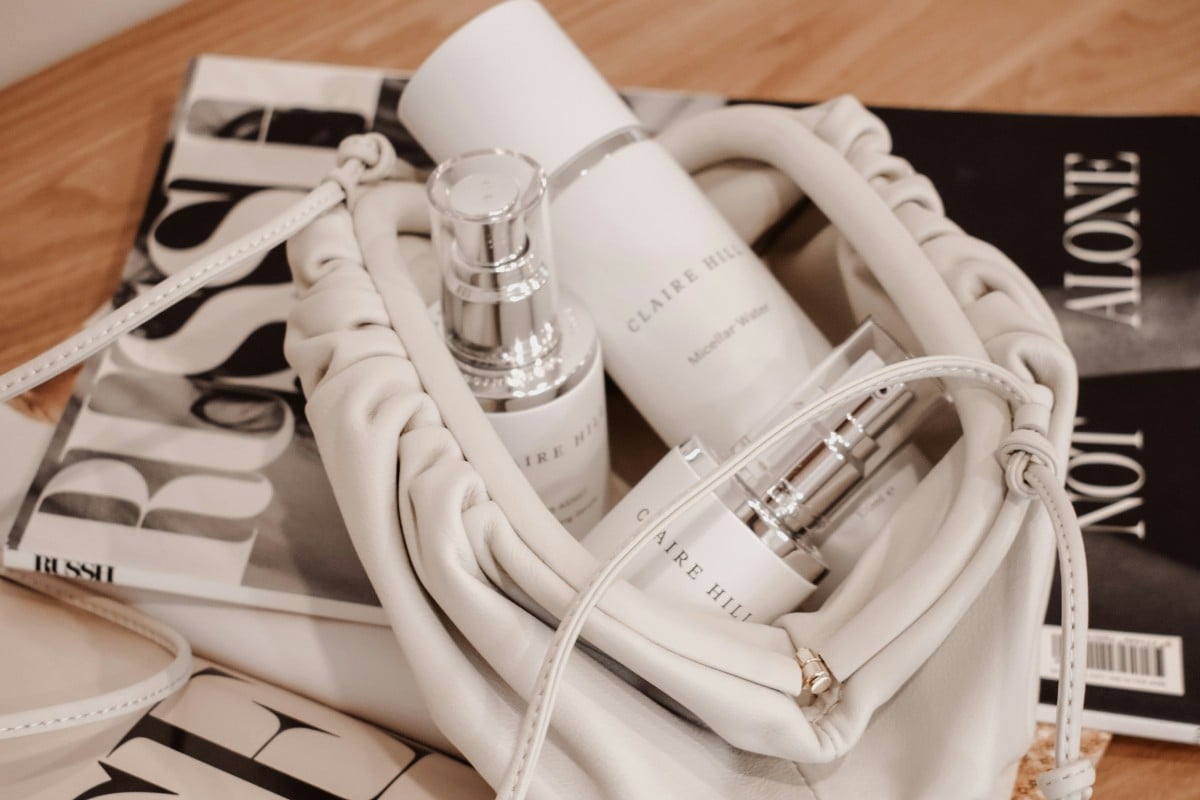It’s a common belief that all moisturizers add hydration to our skin, but this isn’t the whole story. You probably already know that there are three different types of moisturizers: emollients, humectants, and occlusives. And here’s the deal: Only one of these—humectants—specializes in drawing moisture into the skin. The other two, emollients and occlusives, protect the skin’s natural moisture barrier. They don’t increase hydration but rather protect and enhance what’s already there.
Depending on your skin condition and the environment you live in, one moisturizer might be more effective than the other. We’re here to break down the differences between emollients, humectants and occlusives and help you find out which moisturizer is best for your skin.
Emollients
- Emollients are moisturizers that soften and smooth the skin. They’re substances that are similar to our skin’s own fats. Emollients work by filling in the cracks between skin cells and replenishing the skin’s fat layer in dry and rough areas.
- Examples of emollients include squalane, fatty acids, cholesterol, ceramides, shea butter, colloidal oatmeal, dimethicone, and oils rich in fatty acids like jojoba.
- Emollients are ideal for dry, flaky, cracked, or rough skin. They’re also beneficial for conditions like eczema, rosacea, and psoriasis.
- They’re particularly effective in colder, drier climates and work best when applied after showering or bathing when the skin is still moist.
- Heavier emollients like ointments are great for extremely dry skin, while lotions are lighter and suitable for normal to slightly dry skin.
- Emollients usually don’t clog pores, but they can weigh down the skin and leave a greasy residue if you apply them in excessive amounts.
Humectants
- Humectants are moisturizing agents. They bond with water molecules, so they can draw moisture from the atmosphere to the outer layer (epidermis). They are the only moisturizers that increase the water content in the skin cells.
- Common humectants include glycerin, hyaluronic acid, propylene glycol, and urea. Natural humectants include honey and aloe vera.
- Humectants maintain skin hydration and elasticity and are added to anti-aging products due to their plumping effect on fine lines and wrinkles.
- Humectants can reduce dryness and flakiness, especially in humid environments where they can draw more moisture from the air. However, in dry climates, they can potentially draw too much moisture from the skin, causing dehydration.
- Humectant moisturizers are lightweight, non-comedogenic, and quickly absorbed into the skin. They work great for everyone, including those with oily and acne-prone skin, as they provide hydration without clogging pores.
- It’s best to use humectants in combination with occlusives and emollients to lock in the moisture they attract. This is especially the case if you live in a dry climate with humidity levels below 60-70%.

Occlusives
- Occlusives are oily, waxy substances that do not penetrate the skin and instead sit on the surface. There, they create a physical barrier on the skin. This occlusive barrier protects your skin from external irritants and reduces the amount of moisture that evaporates through your pores. In other words, occlusives form a protective layer over the skin’s surface that seals in moisture.
- Common occlusives include petrolatum, beeswax, mineral oil, lanolin, shea butter, olive oil, squalane, silicones, and cocoa butter.
- Occlusives are the MVPs in managing dehydrated skin, eczema, and psoriasis. These conditions are largely the result of the skin losing too much moisture.
- You should apply occlusives as the last product in your nighttime skincare routine. They are most effective when used on moist skin.
- Some occlusives, especially petroleum-based ones, can feel heavy or greasy on the skin. What’s more, there’s a chance that occlusives will clog your pores and hold in bacteria and sebum, which isn’t ideal if you’re dealing with oily skin and acne.
- Occlusives are a key player in skin protection and healing. They provide a protective layer to aid healing and reduce skin infections and wounds. This occlusive layer also protects the skin against extreme cold and harsh winds, which is why occlusives are some of the best skincare ingredients to use in winter.

Emollients vs. humectants vs. occlusive
- Humectants increase skin hydration by drawing moisture into it. However, humectants aren’t that good at holding moisture into the skin. That’s why we need occlusives. Occlusives lock in moisture by forming a protective layer on the skin’s surface. However, neither humectants nor occlusives restore the epidermal barrier, which is the skin’s natural system of protecting and hydrating itself. This is where emollients come in. Emollients soften the skin by filling the cracks between the cells and restoring the skin’s fat layer.
- Compared to humectants, emollients are slightly richer and heavier in texture, but not as heavy and greasy as occlusives.
- Both humectants and emollients are light enough for day and night use, while heavy occlusives are better for nighttime applications.
- Emollients and occlusives work best in colder, drier climates while humectants are effective in humid environments but might exacerbate dryness in dry climates.
- Everyone should use humectants and emollients while people with oily and acne-prone skin should steer clear of heavy occlusive.
- Humectants are molecules with a low molecular weight and they penetrate the skin well but their moisturizing effect can be short-lived if not sealed in. Emollients work on the outer layers of the skin and provide more lasting effects than humectants. On the other hand, occlusives do not penetrate the skin at all and their moisture-sealing properties are lost when they are washed off the face.
How to use emollients, humectants, and occlusives for maximum skin hydration
A well-rounded skincare routine should include a combination of humectants, emollients, and occlusives. This multi-faceted approach ensures that your skin is not only receiving moisture but also retaining it.
Start with the lightest formula (humectants), followed by emollients, and seal with occlusives. This layering technique maximizes the amount of hydration your skin receives. In the morning, using lighter emollients ensures your skin doesn’t feel greasy and is primed for foundation and sunscreen. At night, a more intensive occlusive lock in the active ingredients of your serums and optimize the skin’s natural repair process.
Here’s an example of how to use emollients, humectants, and occlusive:
Every morning and night, start with a hyaluronic acid serum to pull in moisture to your skin. Then, in the morning, use an emollient moisturizer (like one with ceramides and fatty acids). At night, after the serum, switch to a thicker occlusive to lock in the day’s moisture and facilitate skin healing. It’s also a good idea to use occlusives during the day in the colder months, especially if you’re dealing with dry skin.
However, there’s one catch: Don’t use occlusives after treatments like retinol, chemical exfoliants, and microneedling. These treatments increase skin turnover, often leading to increased sensitivity and a need for the skin to ‘breathe’ and heal naturally. Occlusives create a very strong barrier on the skin’s surface. This barrier might hinder the skin’s natural recovery process and block the shedding of dead cells. Instead of occlusives, it’s recommended to use lighter, breathable moisturizers filled with emollients to restore hydration and support skin barrier healing.
Sources
At Women’s Concepts, we’re committed to the highest standards of accuracy and research. We meticulously source our information from credible sources like scientific journals and clinical trials. Every statement and claim in our content is backed by clear references. To understand more about our sources of information and fact-checking process, we invite you to read our editorial policy.
- Purnamawati S, Indrastuti N, Danarti R, Saefudin T. The Role of Moisturizers in Addressing Various Kinds of Dermatitis: A Review. Clin Med Res. 2017 Dec, https://www.ncbi.nlm.nih.gov/pmc/articles/PMC5849435/
- Sethi A, Kaur T, Malhotra SK, Gambhir ML. Moisturizers: The Slippery Road. Indian J Dermatol. 2016 May-Jun, https://www.ncbi.nlm.nih.gov/pmc/articles/PMC4885180/
- Harwood A, Nassereddin A, Krishnamurthy K. Moisturizers. [Updated 2022 May 29]. In: StatPearls [Internet]. Treasure Island (FL): StatPearls Publishing; 2022 Jan, https://www.ncbi.nlm.nih.gov/books/NBK545171/





